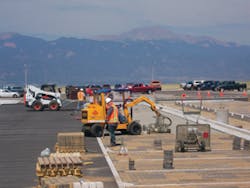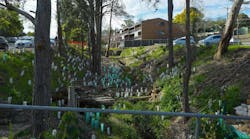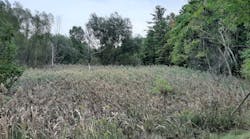Peterson Air Force Base Paves the Way
In 2007, the Energy Independence and Security Act established new stormwater design requirements for federal development and redevelopment projects, mandating the reduction of stormwater runoff to protect water resources. The law states that any projects that increase impervious surface area by 5,000 square feet or more must retain the 95th percentile storm event.
In keeping with the law, Peterson Air Force Base in Colorado needed to make sure no stormwater runoff problems were created as a result of construction. This is of particular concern at the base as the area discharges into nearby Sand Creek and the storm sewer system is at maximum capacity.
In 2009, Fred Brooks, civil engineer with the 21st Civil Engineering Squadron (CES), was tasked with researching options to solve the base’s drainage issues. Flash flooding, inundated storm sewer infrastructure, and runoff were common. Brooks and Randy Hawke, architect for the 21st CES, soon realized that the status quo was no longer acceptable, and something innovative had to be undertaken to address the problem. “We need to ensure we don’t create significant stormwater runoff issues as a result of our construction,” says Hawke.
Paine Street, where minor flooding was a constant problem because of the semi-industrial nature of the area, offered some unusual challenges for the 21st CES. The catchment area incorporates 35 acres and contains many older buildings, all of which drain onto Paine Street, exacerbating the runoff problem. With the surrounding area completely developed, a detention pond was not feasible, and a complete storm sewer upgrade or replacement was too expensive. In addition, any new design for stormwater runoff had to provide a method of controlling the release rate into Sand Creek.
After extensive review, it was determined that the best option for detention, flow control, and project cost was the use of permeable interlocking concrete pavers with an aggregate base storage layer. The landscape contractor, TDF Construction, installed Eco-Priora pavers produced by Pavestone LLC of Colorado Springs, one of the founding members of Uni-Group USA, the nation’s oldest interlocking concrete pavement association. The pavers meet or exceed ASTM C-936 specifications, offer interlocking spacers for superior stability under traffic loading, and are capable of infiltrating stormwater at more than 100 inches per hour. In addition, the minimal chamfer and smooth surface make the Eco-Priora pavers suitable for pedestrian applications and wheelchair access to meet Americans with Disabilities Act (ADA) criteria.
“Permeable pavers permit stormwater and snowmelt to drain through the voids between the paving blocks and into a subsurface detention area,” says Brooks. “They allow water to filter naturally into the ground and ultimately recharge the aquifer, and by creating subsurface detention and filtration areas, the paver system dramatically reduces or even eliminates the need for retention ponds.” Another benefit is that, should underground repairs be needed in the future, “we can “˜unzip’ the pavers, make the repairs, and then reinstall those same pavers,” he adds.
For monitoring purposes, Brooks designed two independent pavement sections. The first incorporated a drainage pipe at the subgrade below an aggregate storage layer, so that during periods of high-volume runoff, the storage layer would provide a buffer for the drainpipe and control the discharge rate while providing site detention. The second section did not include the drainage pipe so that it could provide an opportunity to determine the system’s capability for direct infiltration into the silty/sand subgrade.
The cross-section for the pavement was designed for traffic loading with 11 inches of ASTM No. 2 aggregate, a 4-inch-thick base of No. 57 aggregate, a 2-inch-thick bedding layer of No. 89, and the three-eighteenth-inch-thick Eco-Priora pavers. A woven geotextile was used between the No. 2 aggregate and the subgrade. More than 18,000 square feet of pavers in a multicolor blend were installed at the site in a herringbone pattern.
LEED certification was also an important factor for the base. With the permeable pavers, the designers were able to qualify for stormwater credits through the control of peak flows, erosion mitigation through runoff reduction, decreasing impervious surface area, and increasing onsite infiltration. The contractor was also able to achieve credits for materials resources and regional materials for the project by selecting Pavestone as the local permeable concrete paver supplier.
With the success of this first project, Peterson Air Force Base has incorporated permeable interlocking concrete pavers into its Facility of Excellence Plan, which states, “In order to reduce stormwater runoff and lower long-term infrastructure cost for parking lots, Peterson AFB now requires all new parking lots to utilize a permeable paver sustainable design. All parking stall areas shall be constructed of permeable pavers in a herringbone pattern.” In addition, the Peterson AFB Design Guide mandates that the use of permeable concrete paving systems shall be considered for low-volume roads and that all parking lots with striping use contrasting colored pavers as opposed to painting, which saves on maintenance costs.
The next base project to use permeable pavers was Thule Street, where 18,000 square feet of Eco-Priora pavers were installed by Robertson Landscaping. The existing asphalt street was in poor condition and had a low point in the roadway, which was creating drainage issues that would have required an expensive extension of the storm sewer lines. While the permeable pavement for the project cost was more than the cost of an impervious asphalt pavement, Brooks notes, “The stormwater storage and future maintenance reductions are worth the investment, as the new road is projected to outlast an asphalt roadway by two or three life cycles.”
The project was funded through the American Recovery and Reinvestment Act. The improved aesthetics and permeability were also important because plans call for the development of a new business park concept, which will be designed based on energy savings and sustainability. “Permeable pavers are part of the architectural standards for the park,” says Hawke.
The Base Operations parking lot won a Hardscapes North America Award in 2011 for the paver contractor, Rocky Mountain Hardscapes, which installed 20,000 square feet of Eco-Priora permeable pavers for the parking bays. The permeable pavers complement a highlight of the overall project-a Compass Rose-that was created with traditional pavers.
The 4th Space Control Squadron parking lot expansion was completed in two phases in 2012 and 2013; contractors JBI Construction and Creative Hardscapes installed more than 56,000 square feet of Pavestone’s Eco-Priora pavers in Winter Blend and Limestone.
Mike Midyett, general manager of Pavestone of the Rocky Mountain Region, notes that Peterson Air Force Base recognizes the value of the permeable pavers on many levels, including sustainability, durability, cost effectiveness, and the ability to help meet the requirements of the Energy Independence and Security Act. “The permeable pavers’ success is why they continue to use them for parking lot and street projects for the base,” he says.
Brooks, who is now the environmental element chief for the 21st CES, reports that approximately 116,850 square feet of permeable pavers have been installed to date at the base. “Compared to asphalt, pavers provide a longer design life (45 years versus 25) and lower life-cycle costs (approximately 75%), in addition to improved stormwater mitigation.”
He adds, “We’ve been monitoring these permeable paver installations for over six years now, and we’ve been very impressed with their performance. There has been a dramatic reduction in flooding, snow plowing of the pavers has not presented any problems, and snowmelt drains through the paver joints. Maintenance is minimal with sweeping once a year, and the drainage capacity is still insatiable.”


